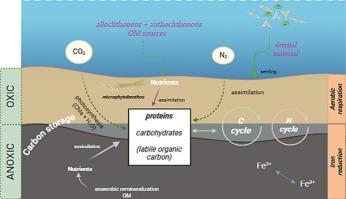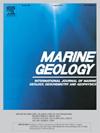Distribution of biochemical components in sedimentary organic matter of a Coastal Wetland: Anthropogenic and detrital influences
IF 2.2
3区 地球科学
Q2 GEOSCIENCES, MULTIDISCIPLINARY
引用次数: 0
Abstract
Coastal wetlands, particularly tidal flats, play a crucial role in carbon sequestration and nutrient cycling in temperate environments. This study investigates the biochemical composition of sedimentary organic matter (SOM) in the tidal flats of Puerto Rosales (Bahía Blanca Estuary, Argentina), emphasizing the dual influences of natural processes and anthropogenic activities. Sampling was conducted seasonally (2014–2015) at two sites: ST1, an intertidal zone affected by untreated sewage discharge, and ST2, a supratidal zone dominated by microbial mats. Surface (0–5 mm) and subsurface (5–10 mm) sediment layers were analyzed to assess early diagenetic processes, SOM component and trophic status. Results indicated that the organic carbon (OC) in sediments was predominantly non-biogenic, with proteins as the major component of the labile fraction, influenced by seasonal phytoplankton blooms and urban discharges. While the tidal flat exhibited meso-oligotrophic to eutrophic conditions, refractory material dominated over labile fractions (proteins and carbohydrates). Additionally, distinct spatial and seasonal variations in SOM quality and composition, linked to redox conditions and organic detrital quality were observed.These findings underscore the ecological importance of Puerto Rosales tidal flats as dynamic systems for carbon storage and nutrient recycling. They highlight the need for sustainable management strategies to mitigate anthropogenic pressures and preserve the critical ecosystem functions of these coastal wetlands.

滨海湿地沉积有机质中生化成分的分布:人为和碎屑的影响
沿海湿地,特别是潮滩,在温带环境中的碳固存和养分循环中起着至关重要的作用。本文研究了Puerto Rosales (Bahía Blanca Estuary, Argentina)潮滩沉积有机质(SOM)的生化组成,强调了自然过程和人为活动的双重影响。在两个地点(2014-2015年)进行了季节性采样:ST1,受未经处理的污水排放影响的潮间带,ST2,以微生物席为主的潮上带。分析了表层(0-5 mm)和地下(5-10 mm)沉积层,以评估早期成岩过程、SOM成分和营养状况。结果表明,沉积物中的有机碳以非生物碳为主,不稳定组分以蛋白质为主,受季节浮游植物华度和城市排放的影响。潮滩呈现中贫营养到富营养状态,难降解物质占主导地位,不稳定组分(蛋白质和碳水化合物)占主导地位。此外,观察到SOM质量和组成的明显空间和季节变化,与氧化还原条件和有机碎屑质量有关。这些发现强调了罗萨莱斯港潮滩作为碳储存和养分循环的动态系统的生态重要性。他们强调需要可持续的管理战略,以减轻人为压力和保护这些沿海湿地的关键生态系统功能。
本文章由计算机程序翻译,如有差异,请以英文原文为准。
求助全文
约1分钟内获得全文
求助全文
来源期刊

Marine Geology
地学-地球科学综合
CiteScore
6.10
自引率
6.90%
发文量
175
审稿时长
21.9 weeks
期刊介绍:
Marine Geology is the premier international journal on marine geological processes in the broadest sense. We seek papers that are comprehensive, interdisciplinary and synthetic that will be lasting contributions to the field. Although most papers are based on regional studies, they must demonstrate new findings of international significance. We accept papers on subjects as diverse as seafloor hydrothermal systems, beach dynamics, early diagenesis, microbiological studies in sediments, palaeoclimate studies and geophysical studies of the seabed. We encourage papers that address emerging new fields, for example the influence of anthropogenic processes on coastal/marine geology and coastal/marine geoarchaeology. We insist that the papers are concerned with the marine realm and that they deal with geology: with rocks, sediments, and physical and chemical processes affecting them. Papers should address scientific hypotheses: highly descriptive data compilations or papers that deal only with marine management and risk assessment should be submitted to other journals. Papers on laboratory or modelling studies must demonstrate direct relevance to marine processes or deposits. The primary criteria for acceptance of papers is that the science is of high quality, novel, significant, and of broad international interest.
 求助内容:
求助内容: 应助结果提醒方式:
应助结果提醒方式:


